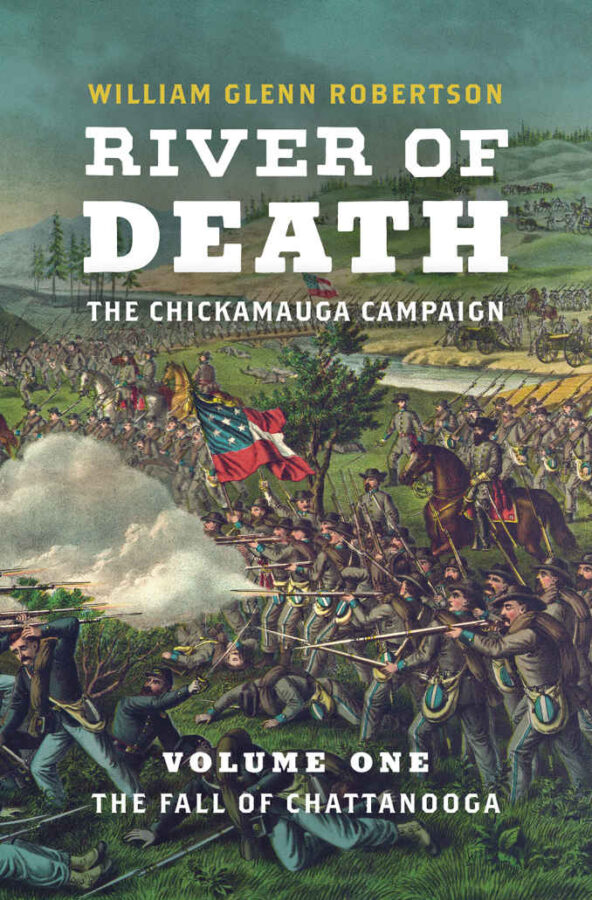River of Death—The Chickamauga Campaign, Volume 1: The Fall of Chattanooga by William Glenn Robertson. University of North Carolina Press, 2018. Cloth. ISBN: 978-1-4696-4312-0. $45.00.
 Few people alive today know more about the Chickamauga Campaign than William Glenn Robertson. As director of the Army’s Combat Studies Institute, Robertson revived the original “staff ride” model in which military professionals would research a campaign and study it on the ground with an eye toward modern implications. He selected Chickamauga as the standard staff ride experience for Command and General Staff College students because of its valuable lessons for understanding the “operational level of war,” the critical bridge between tactics and wider strategy. River of Death therefore is an tome decades in the making, one that helps resurrect the significance of the September 1863 campaign between the Union Army of the Cumberland and the Confederate Army of Tennessee.
Few people alive today know more about the Chickamauga Campaign than William Glenn Robertson. As director of the Army’s Combat Studies Institute, Robertson revived the original “staff ride” model in which military professionals would research a campaign and study it on the ground with an eye toward modern implications. He selected Chickamauga as the standard staff ride experience for Command and General Staff College students because of its valuable lessons for understanding the “operational level of war,” the critical bridge between tactics and wider strategy. River of Death therefore is an tome decades in the making, one that helps resurrect the significance of the September 1863 campaign between the Union Army of the Cumberland and the Confederate Army of Tennessee.
Robertson’s book, only the first volume in a proposed two-part study from UNC Press, carries the two armies from the campaign’s opening moves to the fall of Chattanooga. It offers a remarkable scope. The author balances anecdote and analysis in his sweeping view of the challenges posed by geography, weather, command climate, and technology. No other campaign, Robertson argues, witnessed Civil War armies conquering such dramatic terrain and physical obstacles. He emphasizes the logistical considerations that hampered William Rosecrans’ Union forces, from supplying the army by railroad to bridging the Tennessee River in the face of Braxton Bragg’s Confederates. The result is an authoritative analysis of how the rigors of campaigning affected command decisions and the experiences of common soldiers alike.
Robertson pulls no punches in assessing the campaign’s key leaders. He wisely limits his judgment to what commanders knew at the time, however, a perspective buttressed by a staggering source base of contemporary letters, diaries, and official correspondence. Army of the Cumberland commander Rosecrans comes across as competent but vain, a man who reveled in praise, engrossed himself in micromanagement, and exhibited an unsettling propensity to criticize subordinates in public. His three corps commanders, Robertson shows, were a mixed lot. The author praises George Henry Thomas as reliable, albeit unimaginative. But Thomas Crittenden and Alexander McCook were in over their heads as corps chiefs; the difference was that Crittenden knew it and McCook didn’t. Particularly troubling, the author claims, was the command climate in Crittenden’s Twenty-First Corps, a problem that would contribute to disaster on the battlefield of Chickamauga itself.
On the Confederate side, Robertson’s judicious analysis of Bragg dovetails with Earl Hess’s recent biography of the general and fits a larger trend in recent Civil War literature to reframe controversial commanders (McClellan, Meade, and even Grant being other prominent examples). Robertson’s study makes clear that Bragg’s considerable personal shortcomings should not cloud our appreciation of his operational skill. Instead, the author saves his most scathing criticism for Leonidas Polk, Bragg’s principal subordinate and the pompous ringleader of the high command’s anti-Bragg cabal. Nor do cavalry chiefs Nathan Bedford Forrest and Joseph Wheeler escape blame for their ineffectiveness in supporting major operations.
A fair amount of this massive book deals with the rigorous demands of army staff work. Robertson offers tremendous detail into the careers of the various staff officers at each army headquarters, and readers will glean through his interpretation just how malleable the staffer’s role could be in the Civil War context. Both army commanders blurred the distinction between general staff and personal staff out of necessity. Rosecrans acted as his own intelligence chief, for example, in the absence of anything like the Bureau of Military Information in the Army of the Potomac. Though more implied than stated in the book, the miniscule staffs for Civil War field armies made for a perilously weak central nervous system when it came time to maneuver and fight.
The past several years have witnessed an explosion of literature on the Chickamauga Campaign. Much of that can be credited to David A. Powell, author of an impressive three-volume study of the campaign (among other works), and to a general willingness among military historians to study the war’s Western Theater in finer detail. River of Death, for instance, offers a depth reminiscent of Harry Pfanz’s Gettysburg volumes. Critics will probably allege that some of this detail is extraneous. Indeed, apart from the occasional shell thrown into Chattanooga by Union decoy guns, hardly a shot rings out in all of Robertson’s book. But that same detail adds a common soldier’s perspective on the drudgery of campaigning and shows us the critical importance of logistics, terrain, and overworked army staffs in the Civil War. The drama of Robertson’s book is in the uncertainty at Bragg’s headquarters, the herculean efforts of Rosecrans’ Pioneer Brigade, and the exhausting marches up and over Lookout Mountain’s daunting precipice. Furthermore, this detail serves to anchor an analysis of operational-level decision-making that places Robertson’s book in the same class as Edwin Coddington’s The Gettysburg Campaign. The concluding volume—which still has the dramatic events at McLemore’s Cove and the full Battle of Chickamauga itself—should make this study the authoritative treatment for years to come.
Zachery Fry is an assistant professor in the Department of Military History, U.S. Army Command and General Staff College, Redstone Arsenal.
